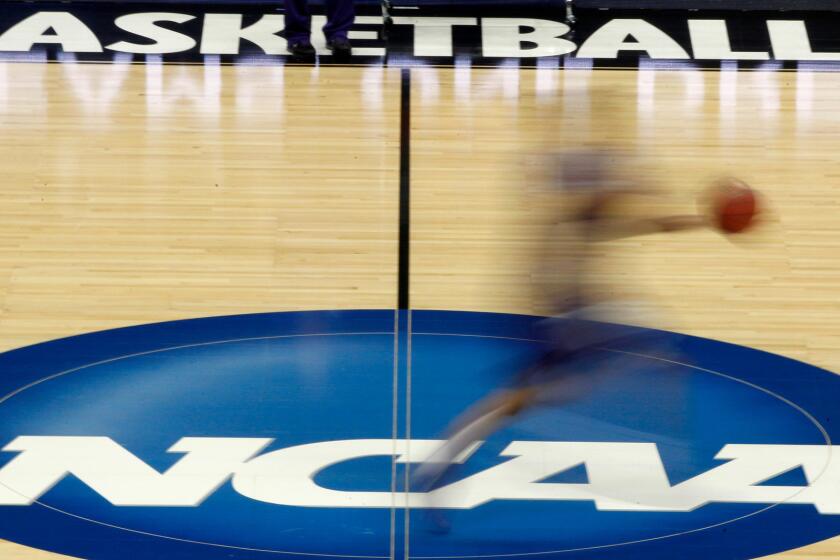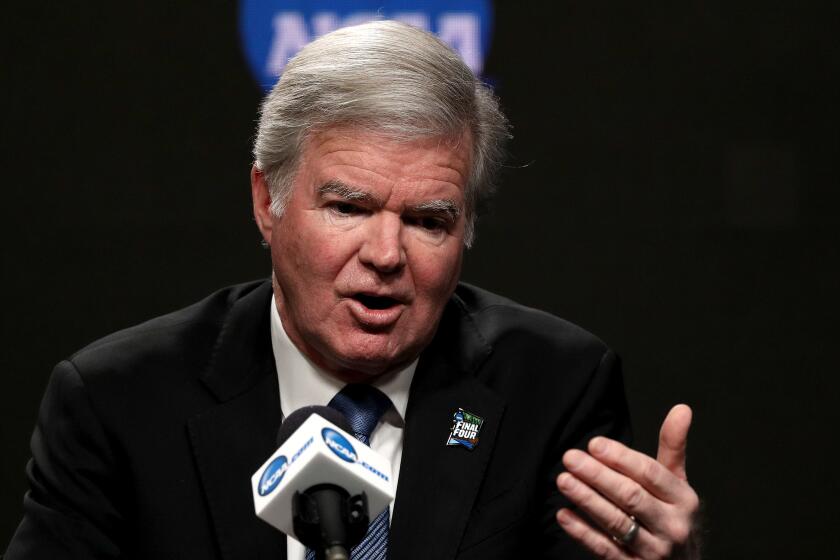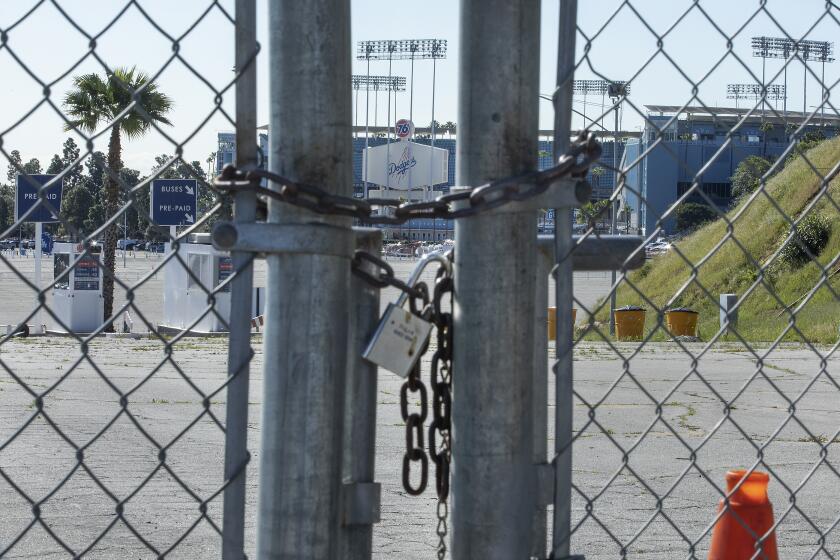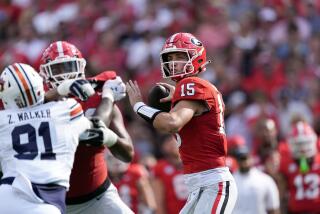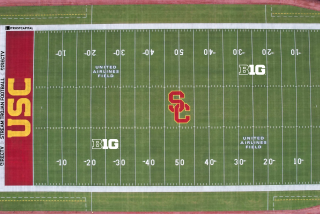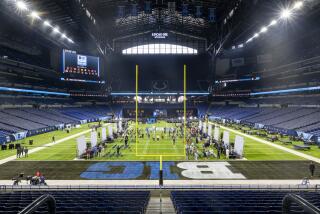Q & A: What the NCAA’s report on name, image and likeness means for college athletes
For the last year, as state legislators across the country crafted senate bills similar to California’s historic SB 206, the NCAA’s working group on federal and state legislation had been preparing for this week, the moment when its recommendations on name, image and likeness would go in front of the Board of Governors.
In that time, with California and Colorado passing laws allowing college athletes to profit from the use of their NILs, the NCAA’s eager critics have often wondered: What’s taking so long?
From the perspective of college sports’ governing body and its membership, blowing up a half-century’s worth of legal precedent based on the ideals of amateurism was never going to be simple. The announcement Wednesday that the board would support athletes being able to profit from third-party endorsements, social media influencing and personal appearances was always going to come with “guardrails” that would serve as new regulations in the midst of loosening past restrictions.
To grasp why the working group’s recommendations needed 31 pages of explanation, and why the NCAA’s first big answer on NIL led to more complex questions, one has to consider just how much weight the association must put on every word that is thrust into the public eye in regard to this topic.
“The NCAA is waging battle on a number of fronts,” said Gabe Feldman, director of the Tulane Sports Law Program. “They are not only trying to modernize their rules to allow more rights for college athletes, but at the same time they are dealing with antitrust litigation, state legislation and possibly federal legislation. They have the difficult task of threading the needle with all those external factors.
College athletes could be compensated for endorsements, social media influencing, personal appearances in plan supported by NCAA Board of Governors.
“Some of this is their own fault because they have delayed getting here, and their delay prompted much of the external action. Regardless of the timing, this is the reality the NCAA faces: In the middle of a pandemic, they are trying to figure out how to satisfy state legislators, federal judges, federal lawmakers and their constituencies. To me, this report was clearly written with all those factors in mind.”
The NCAA won’t know for months whether it succeeded in threading the needle with the strategy behind this announcement. And NCAA President Mark Emmert emphasized numerous times during a news conference that this is only a starting point for further discussions among leaders from all three divisions before actual rules are voted on in January 2021 and put into effect to start the 2021-22 academic year.
Once again, the NCAA has given itself more time. But that doesn’t mean a fresh batch of questions can’t be addressed now.
What would college athletes gain from this plan?
Finally, more money in their pockets. There’s no denying that. At the top end, the recommendations would allow them to hire agents who can help negotiate sponsorship deals. Only the most desirable players would appear on television ads, but many would have an opportunity to earn payments for social media influencing. At a minimum, athletes could use their image to advertise a camp to teach their sport or an autograph signing and be paid for those appearances.
What are the key restrictions?
The NCAA won’t allow athletes to use their NILs in a free market. It wants to make sure schools or their boosters don’t use endorsement payments or promises of deals to lure athletes to their campus. The last thing the organization wants is an above-board bidding war for players, a car dealership in one state offering more than another in a neighboring state to land a five-star recruit.
The NCAA intends to regulate transactions so that boosters don’t have undue influence on the amounts. A body of some kind — possibly a third party — would be developed to approve transactions as having a “fair market value.” While Ohio State athletic director Gene Smith said Wednesday there is “no cap” on what players can make from their NIL, these guardrails will limit their potential earning power and could lead to another legal minefield the NCAA would like to avoid.
The board said that athletes would be prohibited from using their schools’ logos and emblems and intellectual property in any NIL opportunity.
UCLA lost its top recruit in Daishen Nix when the five-star point guard from Las Vegas decided to join the G League academy team.
“In the pro sports environment, you’ll see athletes wearing street clothes. They’re not wearing NBA or NFL uniforms and gear,” said Big East Commissioner Val Ackerman, a co-chair of the working group. “We thought that would be an appropriate limitation to carry over to the college environment because we are intent on keeping separate the NIL endeavors of our athletes. We are not eager to make the school complicit in those arrangements. We think bringing in IP [intellectual property] will make it harder for us to create that separation and what could lead to a slippery slope toward pay for play.”
How is an athlete being paid for his or her NIL by a third party not “pay for play”?
This is an important point in the NCAA’s legal strategy, which is predicated on being able to argue that athletes are not paid for their athletic performance and treated like normal students with benefits from the school only up to the full cost of attendance.
“People have trouble with this concept: If you can’t be paid to play, but you’re famous because you play, aren’t you being paid because you play? I get that,” Feldman said. “But if you look outside of sports and you take an actor, a famous actor and they get paid millions to act and they get paid millions to do a perfume commercial, nobody suggests they’re being paid in the commercial to act, even though the value comes from what they do on the screen. You can draw a clear line between the two.”
The NCAA would not be going forward with these changes if it wasn’t confident the court would agree with Feldman.
The reason that group licensing arrangements are not included in the plan is that cutting players in on a percentage of television revenue or rebroadcast rights would constitute pay for play and ruin the NCAA’s legal defense arguments.
Does no group licensing mean no EA Sports NCAA football video game?
For many sports fans, this is the only question that truly matters. Sadly for the thousands of diehards who remain obsessed with the idea of the game returning, the answer is, yes, they’re stuck with Madden for now.
But the NCAA has again proven that its definition of amateurism is a moving target, and a mention in the report that the association could ask Congress about how group licensing could fit within the amateur model should be a glimmer of hope.
What will the NCAA be wanting from Congress?
Everything, apparently. Wednesday, the NCAA spelled out that it needs Congress to pass a national NIL law that preempts the 30-plus state laws that are in the works and also offers an antitrust exemption to allow it to adjust rules as it sees fit without fear of retribution from future plaintiffs.
If Congress doesn’t act — it certainly does not have to, by any ways and means — the NCAA will be forced to deal on a state-by-state basis, starting with Florida’s NIL bill, which would go into effect in July 2021 and offers athletes the opportunity to earn with few restrictions in place.
A proposal that would allow Division I sports teams to be cut amid the coronavirus crisis has created concern among coaches and athletics officials.
“I don’t think they have any leverage,” said U.S. Rep. Mark Walker (R-N.C.), who put forth an NIL bill in March 2019, “just like any other entity who has exhibited bad behavior. There’s no reason these guys get a pass. They came to the table kicking and screaming after pushing against any kind of equity for student-athletes for three decades.
“The NCAA has to play ball now, so they’re trying to grasp these last straws to make it all work out in their favor, and some could make the case, they’ve waited too late.”
Why would Congress bail out the NCAA if it has no leverage?
It will be interesting to see if federal legislators push for the NCAA to cough up more — in the form of fewer NIL restrictions or approving group licensing arrangements with players — in exchange for an antitrust exemption that protects them from being sued.
“I think they would fold like a cheap suit,” Walker said. “Before you lay an antitrust exemption on the table, we need to set the parameters and guidelines and also the timeline when they should be implemented.”
What can state legislators do with the NCAA focusing on Congress?
Keep the pressure on and turn those bills and drafts into laws like California did, according to Sen. Nancy Skinner, the co-author of SB 206.
“The good news is that across the country we are sort of moving as one voice,” Skinner said. “That clearly communicates to the NCAA that we feel student-athletes really deserve some extensive rights like all other Americans enjoy. Now, that said, our colleges do want to be part of championships and such. This is going to be an interesting experience to see whether all of us as states that feel strongly about this and the NCAA can meet a common ground.”
California’s law presents no limit to what an athlete can earn from NIL other than prohibiting endorsements that conflict with a university’s sponsorship deal.
Skinner did not appreciate that under the NCAA’s recommendations former UCLA gymnast Katelyn Ohashi would not have been able to own the rights to a photo of her wearing Bruins gear or performing in one of the thrilling floor routines that brought her momentary fame a year ago.
“It’s appropriate to have guardrails on boosters,” Skinner said, “but the rules should not be too restrictive.”
How limiting is a restriction on athletes using school logos and IP?
Quite a bit, actually — for the athletes and their athletic departments that would would have been able to capitalize as well.
“I went into this thinking we were going to have a true power of three situations, where the brand, the school and the athlete were going to do things together,” said Jim Cavale, the chief executive of INFLCR, a software platform for sports teams to store, track and deliver content to their athletes for use on their social media accounts. “I thought it was going to be a rising tide lifts all boats situation that would maximize student-athlete value opportunities.
If you hold tickets for sporting events or concerts that have been canceled or postponed, here’s what the leagues and ticket sellers are doing.
“Instead, it’s the power of two. The brand is either working with the school or the athlete. They’re not working together with clear aspirations for group licensing or any type of union that would help group licensing become a reality. This is really going to limit and cap the market value of a student-athlete’s NIL.”
Simply put, an athlete’s endorsement is worth more if he’s wearing the school’s official gear or standing in the stadium or arena as a backdrop. The school’s sponsorship deal is worth more if the player can be used in it.
A few weeks ago, Notre Dame athletic director Jack Swarbrick said that he was in favor of schools and their athletes being able to team up through NIL use that would benefit all.
“For many of our students, the greatest value of the activity they choose to do is if they can affiliate it with the school brand,” Swarbrick said. “I hope we’re in a position to be a partner with them, to allow them to do the instructional video in the school uniform for example. I hope there’s a way to be co-licensee, co-participant, but I hope our colleges and universities aren’t becoming arbiters or agents for deals.”
As of this moment, the NCAA is not ready to toe that tricky balance.
More to Read
Go beyond the scoreboard
Get the latest on L.A.'s teams in the daily Sports Report newsletter.
You may occasionally receive promotional content from the Los Angeles Times.

